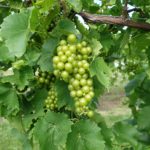Codling moths are flying in some parts of the state. Place your pheromone traps in the orchard during bloom. I have not yet caught any in my traps but expect to soon. We define biofix as the first sustained flight of moths. Therefore, we don’t determine biofix when that first moth shows up in the[Read More…]
Stone Fruits
As the spray season approaches, it is good to remember the profound impact water quality has on the performance of pesticides used by fruit growers. Purdue Pesticides Program recently published a guide, The Impact of Water Quality on Pesticide Performance PPP-86, available at the Education Store, 1-888-EXT-INFO or www.extension.purdue.edu/store/. I highly recommend this guide to[Read More…]
The results of a historical primate behavior analysis suggest that species with fruit-filled diets evolved larger brains. A popular theory among evolutionary biologists is that we have our sociability to thank for our big brains. This “social brain hypothesis” suggests that the mental effort involved in interacting with others eventually increased our cognitive capacity. However,[Read More…]
Following a very early warm-up, temperatures cooled off the middle of March slowing crop development and bringing us back closer to normal. In southern areas, peaches are in full bloom, but only just showing a little pink in more northern areas. Apples are still in tight cluster and probably at least 10 days from full[Read More…]
We just completed a new publication that will assist fruit and vegetable growers in protecting pollinators while still managing their insect pests. The title is “Protecting Pollinators in Fruit and Vegetable Production.” It can be found at https://extension.entm.purdue.edu/publications/POL-2/POL-2.html. There are two companion publications in this series, “Protecting Pollinators in Home Lawns and Landscapes” and “Protecting[Read More…]
This pest has been extremely common in many locations this year. They can cause defoliation of a number of fruit crops and can be especially devastating to young trees, so they need to be controlled to prevent losses. They also like to feed on most of the small fruits, early maturing varieties of apples, and[Read More…]
Mites continue to be a concern for both fruit and vegetable growers. We are just now at the historical peak population time for European red mites. Fruit growers should be scouting their more susceptible blocks regularly for the next few weeks. The thresholds for treatment increase as we get later in the season. See https://extension.entm.purdue.edu/publications/E-258/E-258.html[Read More…]



